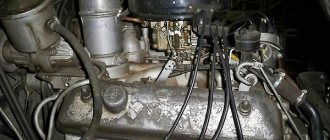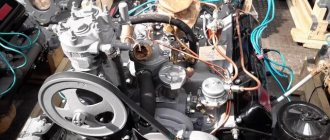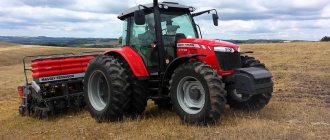The need for the transportation of liquid cargo has arisen since ancient times, and with the advent of cars, the transportation of gasoline and other fuels and lubricants began to be required. The first car of the Gorky Automobile Plant, on which they began to install a barrel for transporting liquids, was the legendary GAZ AA. GAZ special vehicles transported various fuels, liquefied gas, cement, flour, water, and milk. Vacuum cleaning machines were also produced.
Milk tanker based on Gazelle
Technical characteristics of GAZ-5312
The car has the following characteristics:
- length 6395 mm;
- width – 2280 mm;
- height – 2190 mm;
- wheelbase – 3700 mm;
- ground clearance (clearance) – 265 mm;
- maximum speed is 90 km/h.
- average gasoline consumption is 24 l/100 km.
Be sure to read: Technical characteristics of MAZ-54329
The passport consumption is indicated for uniform movement at a speed of 40 km/h, and even without a load. Therefore, this value differs markedly from the one obtained in practice. Despite the stated performance characteristics, in real operation the “appetite” was greater – 27 liters “per hundred” for an empty Lawn and up to 32 l/100 km for a loaded one.
Body dimensions
The body is made of wood, so if necessary, it can be easily repaired by replacing rotten elements with new ones, or even extending the sides (as was often done). The dimensions are as follows:
- length – 3740 mm;
- width – 2170 mm;
- side height – 680 mm.
Car load capacity
GAZ-5312 can carry up to 4.5 tons. It is the increased load capacity that is one of the main differences from other modifications. In particular, for the GAZ-53F (1963-1965) this figure is exactly 3 tons, and for the GAZ-53, produced from 1965 to 1983, it is 3.5 tons.
In practice, this figure was constantly exceeded, despite the relatively low-power motor. If necessary, they loaded as much as they could fit.
Vehicle dimensions
Weight
The curb weight of the GAZ-5312 is 3200 kg. And the full one is 8250 kg.
Gasoline tanker
Fuel trucks can be of three types: tanker, tank-trailer and tank-semi-trailer. The GAZ 53 fuel tanker is a tank truck, since the fuel barrel is installed directly on the chassis. Unlike other tanks, gasoline tankers carry gasoline or diesel fuel.
Fuel tanker tank for transporting fuel
A fuel tanker also refers to a fuel tanker. This equipment is additionally equipped with a fuel nozzle, a drain pump and a fuel meter.
Diesel car engine
The engine on the GAZ-53 (ZMZ-53) truck is a V-shaped, eight-cylinder (two rows of four cylinders), carburetor type, operating on a four-stroke cycle.
The working volume of the internal combustion engine cylinders of the GAZ-53 car is 4.25 liters (with a cylinder cross-sectional size of 92 mm and piston strokes of 80 mm).
Technical specifications for power 115 hp. With. The GAZ-53 engine is started using a starter.
The nominal crankshaft revolutions per minute are 3,200. The mixture compression ratio is 6.7.
Systems and mechanisms
The cylinder block is made of casting from Al-4 alloy, after casting it is sealed by heat treatment and impregnation with synthetic resin. This is a monoblock V-shaped design with an angle along the cylinder axes of 90 degrees.
The cavities of the block and cast iron liners for the pistons form the water cooling jacket of the engine. The possibility of repair replacement of sleeves is provided (5 groups with letter designations). The clutch housing is secured to the end of the block with threaded rods.
The piston group is cast from Al-30 aluminum alloy. The piston is round in shape with a flat bottom; three grooves are cut into its body for oil scraper and compression rings.
Pistons are divided into 5 repair groups according to their own diameter (letter marking) and into 4 groups according to the diameter of the piston pin hole (color marking).
The block heads are made of Al-4 alloy. Valve seats are made of cast iron, guide bushings are made of copper-graphite ceramics. The block and cylinder heads are connected by threaded rods through gaskets made of asbestos board reinforced with steel.
The crankshaft is cast from cast iron, with connecting rod journals, bearings and counterweights formed on it. The shaft undergoes dynamic and static balancing.
Axial movement of the crankshaft is eliminated by two washers installed on either side of the first journal support. It is sealed in the block with oil-sinking grooves, oil seals and asbestos packing.
The gas distribution mechanism with overhead valve installation ensures the intake of the working mixture into the cylinders and the exhaust of exhaust gas.
The device consists of: camshafts and gears, pushers, rocker arms, rods, valves, guide bushings and springs.
The camshaft is forged from steel. It has five bearing journals, cams, a gear drive for an oil pump and an ignition distributor.
The power system includes: a 90-liter gas tank, pipelines, a mechanically driven diaphragm pump, fuel filtering devices and a two-chamber K-126 carburetor - a device for preparing a fuel-air mixture.
The lubrication system supplies oil to the rubbing parts under pressure and gravity. Gear oil pump driven by a camshaft, full-flow oil filter, serviceable.
The air preparation filter is serviceable, inertial, with sedimentation of polluting particles in an oil bath.
Cooling system with water pump, closed type, liquid. It consists of a water jacket of the cylinder block, radiator, pump, thermostat, shutters, fan, fan casing, radiator cap and connecting hoses. Capacity – 22 liters. Contact ignition system.
GAZ-5312 device
Under the high hood there is a petrol V-shaped six-cylinder engine ZMZ-53-11. Its volume is 4.25 liters and its power is 120 hp. (5 hp more than its predecessor). The gearbox is four-speed. There are no synchronizers at all, so you only need to change gears by pressing the clutch twice and shifting the throttle.
The car is based on a rigid steel frame. The front suspension uses longitudinal semi-elliptical springs, as well as telescopic hydraulic shock absorbers. In the rear suspension, in addition to the main springs, there are also springs. The fuel tank on the GAZ-5312 is located on the side, on the frame. In earlier versions it was installed between the cab and the body.
Be sure to read: Technical characteristics of MAZ-53366
The steering includes a working pair consisting of a globoidal worm and a three-ridge roller. The crankcase was attached to the frame using bolts and nuts.
Brakes are drum brakes on all wheels. Drive – hydraulic. There are also a hydraulic vacuum booster and a drum handbrake. All elements of the brake system had a low service life and had to be replaced and repaired frequently.
The wiring system is single-wire. Electrical voltage is 6 volts. Nowadays such a solution is no longer found (12 volts on cars, usually 24 on trucks).
Reviews from drivers and owners of GAZ-53
By the way, what do people who have had the opportunity to work on the main medium-tonnage truck of the Union republics and socialist countries say? What advantages and disadvantages will they highlight in this car?
Of the advantages, the first place is the simplicity of the design and direct operation of the machine. On the second - amazing maintainability. To eliminate any minor or major breakdown, no special devices, equipment or tools are required; you don't need to be a qualified specialist. To completely overhaul the engine and gearbox, a couple of days will be enough.
Another undoubted advantage is the durability of the machine during its “killer” operation in extreme conditions. Extremely strong chassis: everything around can “rot” and crumble from old age, but the GAZon hubs and bridges will remain.
“The rear axle is a part that has never been repaired at all, and no one has ever changed the oil there since 1984,” shares his impressions of the owner of a GAZ-53, who to this day uses it (already converted to gas) in his farm, there is practically no corrosion, everything is intact.”
Indeed, one can only speak in superlatives about the quality of the metal of LAWNs produced in the 80s. On the next generation of trucks, the metal was much worse, much more susceptible to corrosion and less durable.
In general, the average period of active operation of a truck could be different - depending on the conditions in which it had to work and the total mileage. On collective farms, where perhaps the most significant part of the 53s “served,” the truck worked for an average of 12 years before being written off.
The capabilities of the GAZ-53 engine were very limited, and it really could not carry more than the 4-4.5 tons required by the passport. Although, naturally, they tried to overload it often, everywhere and everywhere.
For example, with extended sides, grain was loaded from a combine up to seven tons at a time (instead of four and a half). But with great difficulty the engine power was enough to cope with the high load. A lawn that is loaded “to the fullest” or “with allowance” pulls very poorly, even up a not very steep hill you need to “climb” in first gear, and the engine also begins to overheat.
Under conditions of merciless operation, GAZ-53 engines operated for only 100-150 thousand kilometers before the first major overhaul; where conditions were more favorable - and 400 thousand. The engine overhaul could be done at least three times.
The weak point in the LAWN design is the clutch disc; the splines are only enough for one season of intensive work. The support bearing in the crankshaft also did not always last more than a season; Problems with the release bearing are also noted.
The steering is mechanical, tight, and sometimes hits your hands. But there was no talk of any amplifiers in those days. Another disadvantage - high fuel consumption - was also insignificant in the Soviet era.
Now it’s hard to imagine, but then gasoline was cheaper than mineral water: in the 70s, 6-8 kopecks per liter; in the 80s it was already more expensive, but even then the absolute maximum cost of gasoline was 30 kopecks per liter. Therefore, GAZ-53, converted from gasoline to gas, has already become the “child of perestroika.”
How much does a 4 cube barrel weigh?
I am selling a water container in excellent condition. Length 516 cm, diameter 100 cm, wall thickness 10 mm. Weight approximately 1300 kg.
Interesting materials:
How to launch the Sims 3 game without a launcher? How to run the game in a Windows 10 window? How to run an old game in full screen? How to earn diamonds in the game Hay Day? How to charge a soul stone in Skyrim? How do you say hello in Game of Thrones? What is the name of the faceless one in Game of Thrones? What is the name of the Khaleesi from Game of Thrones? What was the name of the main dragon in Game of Thrones? Which actress played Baba Shura in Love and Doves?
Fuel truck based on GAZ-53: budova, technical characteristics, photos and videos
Fuel trucks based on the GAZ-53 have at this time earned the popularity of commercial vehicles, which are built on the basis of a GAZ van for a tank (barrel) for short-term storage and long-distance transportation of light petroleum products ів (gasoline and ін).
- 1 GAZ-53 fuel truck
- 2 Device
- 3 Technical characteristics
Fuel truck GAZ-53
The main feature of these tank trucks is the chassis produced by the Gorky Automobile Plant with the GAZ-53 brand, which was produced in a serial version from 1961 to 1993. They are third-generation mid-size cars from the GAZ model range of similar vantage point, with a total production volume of more than 4 million units. Having become the most popular Radian vantage, this machine is small without modification - self-skids, tractor-trailers, utility vehicles, milk tankers, fuel tankers, etc.
The advantages of stagnation of the GAS base for the transportation of gasoline products depend on the following factors:
- Reliability of the machine itself;
- I will add simplicity and, as a result, accessibility to in-line repairs;
- The engine's service life is up to 400 thousand kilometers;
- Possibility of accommodating up to 3 people in the cabin, which allows personnel to change positions and take part in other activities in the event of an emergency;
- All-metal construction to ensure safe maintenance;
- Cheaper prices for spare parts from repair robots.
An elliptical cut tank is installed on the base chassis, which gives the vehicle the greatest compactness and maneuverability in Russia by local area. In this case, the car is adapted to the minds of the Russian climate and roads, both on a modern basis and for a tank tank. Photo of a fuel truck based on GAZ 53
Pristriy
Fuel trucks based on the GAZ-53 seem to be characteristic of the brand and the features of a particular model - a small cabin with a long hood and protruding fenders, as well as an oval barrel with a pump. These units offer a wide range of capabilities and are entirely dependent on the technical configuration of the device:
- The installation of a ZMZ-53 engine (carburetor, 4-stroke, with 8 working cylinders) gives an equally high power for a medium-duty truck - 125 hp.
- The gearbox is equipped with 5 speeds – 4 forward gears and one reverse gear.
- The chassis is represented by 2 axles with a wheel formula of 4*2 and a stale leaf spring suspension, equipped with telescopic shock absorbers to give the machine a smoother ride.
- The transmission mechanism is a mechanical 4-speed unit.
- The steering wheel is without hydraulic power, which makes the controls more complicated and significantly simplifies the design.
- The galvanic system is of the drum type.
- The tank (barrel) is oval in shape, welded from high-grade sheet steel, rolled horizontally, with internal stiffening ribs for increased durability and safety (containments include damage to the barrel due to external mechanical injections, as well as as a result of internal hydraulic shocks).
- The pump with which the tank is equipped is of the vane-center type and is driven to the lifting motor through the PTO.
Dimensions of the GAZ-53 fuel truck
UVAGA! The carburetor engine of the “hard worker” produces a decent amount of engine power, so in order to save money, each model is equipped with MMZ D-245 diesel units.
Technical characteristics
Technical characteristics of the GAZ-53 fuel tanker:
Video inspection of the GAZ-53 fuel truck:
nastanova.com











